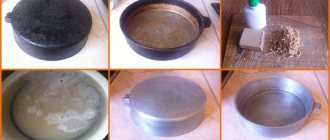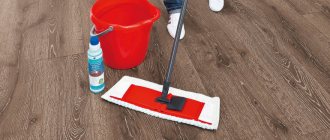During use, the brush loses its whiteness and an unpleasant odor appears. Bacteria and microorganisms begin to multiply intensively, which is harmful to human health. Cleaning the toilet with such a brush will not bring the desired effect, and from an aesthetic point of view it is an unpleasant sight. There are cleaning methods that will help return the brush not only to its former whiteness, but are also an excellent disinfectant. Knowing how to clean a toilet brush white can prevent the spread of bacteria and extend the life of the accessory.
Domestos or Silit
Toilet cleaners also do an excellent job of removing stains from the brush. Such household chemicals as Silit, Domestos and Duckling in a black bottle have proven themselves well.
Methods for cleaning a toilet brush:
- Pour half a bucket of warm water and dilute a plumbing cleaner in it. Dip a brush into the resulting mixture and leave for three hours. Then rinse the brush under running water.
- Apply Domestos or any other household chemical to the inner surface of the toilet and clean it with a brush. Rinse off the water. Pour the product back in, insert the brush, and soak for half an hour. Rinse. Press the brush between the toilet and the lowered seat for about 15 minutes to let the water drain out.
While soaking, it is better to leave the brush and tray in the yard or on the balcony so as not to breathe in harmful fumes. You need to wear gloves when working with aggressive household chemicals.
Pollution Prevention
Preventive measures help preserve the freshness of the brush for a long time and increase its service life:
- It is undesirable to flush leftover food down the toilet - sticky, coloring, or high in fat content.
- After each treatment, rinse the bristles; do not store the device dirty.
- Before placing the brush in the stand, it is advisable to dry it. You can leave the device sandwiched between the lowered seat and the toilet for 20 minutes.
It is not difficult to remove dirt from the brush - after cleaning the toilet, just pour a special product into the drain and place the brush there for 1 hour. If the device is heavily soiled, special solutions and home remedies will restore freshness.
Table vinegar, baking soda and salt
Regular table vinegar will quickly and easily clean your toilet brush white and eliminate unpleasant odors. This method does not harm the bristles, so it can be used weekly.
Cleaning method:
- Take a suitable container, which you don’t mind throwing away later. Pour any cleaning agent into it.
- Combine half a glass of baking soda with a pinch of salt. Pour in ¼ cup vinegar. Mix and place in a container. Pour a small amount of boiling water over everything. Stir.
- Dip a toilet brush into the mixture and leave for two hours. Rinse under running water.
Vinegar will also help get rid of limescale on the tank. To do this, pour a glass of vinegar into it and leave for an hour. After the allotted time, clean out the remaining deposits and rinse the tank.
How often should you wash your brush?
The toilet brush needs regular cleaning and replacement. It is stored only in a special stand, which is also washed periodically. You need to rinse the device with water and a cleaning agent after each cleaning of the toilet. Thorough soaking in solutions is required when the brush is obviously dirty or changes its color, but at least once a month.
The device must be changed once every 3-6 months. If no treatment is carried out, then more often - once a month.
Tips for using, caring for and storing a toilet brush
Recommendations for storing a toilet brush that will prevent the appearance of an unpleasant odor and the spread of bacteria:
- the brush can only be left in the stand; under no circumstances should it be thrown onto the floor;
- For a hanging accessory, it is imperative to provide a container to collect residual liquid;
- Toilet cleaning devices should be placed as close to the toilet as possible so that when moving it to a storage location, residual liquid does not fall on the floor.
From time to time you need to buy a new accessory to care for your toilet. There is no specific period, it all depends on the condition of the brush. If the bristles become sparse and the brush does not clean the plumbing fixtures well, it should be replaced.
- Author: nataliaz2008
Rate this article:
- 5
- 4
- 3
- 2
- 1
(6 votes, average: 3.2 out of 5)
Share with your friends!
Disinfectants
Due to the fact that this device is constantly in contact with waste, it is recommended to periodically disinfect the brush. For this, both traditional methods and store-bought products are used.
White
Whiteness is distinguished by the pungent smell of chlorine, which is responsible for the disinfection of processed items. It is recommended to periodically soak the toilet accessory in this liquid for an hour.
Toilet duckling
Like white, Toilet Duck emits an unpleasant and pungent odor due to the fact that the liquid contains chlorine. However, the second remedy is considered more effective. Toilet duck is capable of destroying various pathogenic microorganisms.
Hydrogen peroxide
This affordable product is used to disinfect various items, including toilet accessories. Hydrogen peroxide is characterized by increased activity. In this regard, the toilet brush should not be washed frequently in this liquid.
Potassium permangantsovka
A solution of potassium permanganate copes well with staphylococcus and a number of other pathogenic microorganisms. Unlike peroxide, this product does not affect the toilet accessory. Therefore, a solution of potassium permanganate can often be used to disinfect household appliances.
Manufacturing materials
Let us immediately note that in this section we are talking mainly about the material from which the glass is made.
Plastic
This material is the cheapest. It can have an original shape and a variety of colors. It’s not a shame to throw it away when replacing it. However, plastic products are not particularly durable - they break easily. And besides, they are not always as hygienic as glass or stainless steel.
And this is not the limit for the wild imagination of designers. For example, plastic pipe cleaners are available in the form:
- plants in pots;
- champagne glasses;
- giraffes;
- machine guns;
- funny cats;
- bowling pins.
Plastic toilet brush Verm-N
Ceramics
Porcelain and earthenware containers look very elegant and luxurious. They have one problem - they fight easily. Therefore, such a brush is suitable only for those who are neat. Similar products are produced by many European manufacturers.
French designers of the brand “Comptoir de Famille” have created a very cute and cozy floor model of a brush called “Angel”. Its container is made in the form of a ceramic jug, decorated with an elegant monogram on the side. The brush handle is metal.
Here's another lovely (but expensive) designer flooring product from the German company. The rectangular, snow-white container is made of porcelain, and the shiny metal handle of the brush is made in the shape of a tree branch.
Photo of Provence ceramic toilet brush
Bronze and other metals
If you want to add a little antiquity and classics to your decor, you can purchase an elegant toilet brush made of brass, bronze (perhaps even cast iron), decorated with casting, forging or other interesting elements.
- For example, the wall-mounted model of the metal toilet brush “Piglet PI-0731” is equipped with a frosted glass cup held by a funny pig cast in bronze. The product is part of the Piglet collection of designer accessories. Note that toilet brushes in the shape of animals are now at the peak of popularity.
- And the wall-mounted model “4411” from the French brand “COMPTOIR de FAMILLE” is very solid and weighty. Its base is cast from cast iron and decorated with intricate curls holding the long handle of a brush.
- Modern bathroom styles often feature an abundance of shiny chrome surfaces. Many brushes are made in this spirit, the containers of which are made of stainless steel. As a rule, they have a strict cylindrical or cubic shape.
- Ikea has many beautiful models made of shiny stainless steel. For example, "Kalkrgund". Its cylindrical glass has a side hole, the head of the brush can be removed and replaced (with a Losnen brush). The handle is also made of stainless steel.
Metal toilet brush BRONZE Fuente Real
Glass
If it is strong enough (preferably hardened), then this is an excellent option. Neat, beautiful, hygienic. And it suits almost any style.
An example is the wall-mounted model “VTFNRXQ” from the famous. The cylindrical container, reminiscent of a bucket, is made of durable frosted glass and equipped with a plastic lid. The long handle of the brush is made of chrome-plated brass, and its brush is a practical black color. The cover can be fixed on the handle in several positions.
Photo of toilet brush with frosted glass glass C5511
Acrylic
Modern material, increasingly filling our lives. They even make baths from it, which perfectly retain heat. This durable polymer is very flexible and allows you to create beautiful and original products (both in color and shape). This brush is easy to clean and looks modern and stylish.
An example of an acrylic product is the snow-white floor model “Tatkraft Immanuel Olive”, decorated with a beautiful purple pattern (there is also a beige version). Durable, lightweight (only 0.61 kilograms), moisture-resistant vessel with rounded edges also has an antibacterial coating.
Finally, we’ll tell you how to clean a toilet brush.
Toilet brush with acrylic glass ART MOON Immanuel Green
Choosing the optimal model
Although there are quite a few different ways to clean a brush, it is still recommended to change it from time to time. It is best to choose an accessory based on personal preferences, as well as the structural features of the restroom:
- You should carefully study the handle of the object. Evaluate its convenience, as well as the material that was used in its manufacture. It is not recommended to purchase an accessory made of fragile materials.
- The fibers of the working part should be quite stiff. This increases cleaning efficiency.
- You can purchase a model that is disassembled.
- Don't forget about the aesthetic part. It is best to choose a model that fits perfectly into the interior.
By regularly cleaning a toiletry item and periodically replacing it with a new product, you don’t have to worry about the development of pathogenic bacteria in your toilet.
Source
Recommendations
To make the owner happy with the result of washing your beloved assistant, you can use the following recommendations:
- If it is possible to unscrew the removable elements, do so.
- Never use powders or other products with abrasive ingredients.
- Avoid temperature changes; do not wash the multicooker with cold water.
- After finishing washing, wipe the kitchen unit dry.
The quality of cleaning the multicooker depends on the choice of detergent.
Liquid dishwashing gel
Simple daily dirt, carbon deposits and grease can be easily removed using a traditional liquid gel dishwashing detergent.
After washing, it is important to completely rinse off any remaining product and wipe the multicooker dry with a soft cloth.
Soft sponge or cloth to wipe dry
When choosing a material for wiping, you need to pay attention to the fluffiness of the napkin, rag or sponge. There should be no pellets or hairs left on the surface of the multicooker, especially on the heating element.
They may burn or get into your food. In addition, the cloth should be soft so as not to leave micro-scratches or damage on the surface.
How to clean the bottom?
The bottom of the multicooker is cleaned when the heating element has cooled down. Minor stains can be easily removed with a damp cloth. When removing burnt fat, you can use baking soda or citric acid, which has a dual effect: it removes old stains and unpleasant odors, and also disinfects the surface. You can clean the bottom using cotton pads and a soft, lint-free cloth.
How to clean the lid?
The multicooker lid is in close contact with the food being prepared. Consists of a steam valve, surface and rubber seal. To properly clean the lid, the elements must be separated.
Removable
All removable elements of the multicooker are washed separately, cleaned of old dirt, rinsed thoroughly, wiped dry and assembled.
Fixed
When washing a non-removable lid, the main part of the kitchen appliance is covered with polyethylene and tilted over the sink. After all manipulations, household appliances are rinsed and wiped dry.
Washing the moisture collector
The moisture collector collects remaining condensation and moisture after cooking. It must be washed after each cooking. The collected water is drained, and the container itself is washed with soapy water and wiped with a soft sponge.
How to clean a steam valve
The correct taste and aroma of cooked dishes depends on the cleanliness of the steam valve (be it a Redmond or Polaris multicooker). If the steam valve is dirty, the steam does not find a way out of the pan body, the cooked food “runs away”, and often floods the heating element.
Remaining food and fat particles create an unpleasant odor inside the multicooker. First of all, the valve is washed with running warm water, then cleaned with a brush to remove dirt using citric acid, rinsed, wiped dry and installed in place.
The outside of the multicooker is cleaned using household chemicals. You can use melamine sponges and cleaning powders. In order to remove fingerprints from chrome surfaces, you can use products containing ammonia.
What is it for?
How to use a bidet correctly
As already mentioned, the main purpose of a bidet is to wash the genitals after visiting the toilet. The device simplifies the washing procedure and helps maintain personal hygiene.
It is important that it is much easier and more convenient for people with disabilities, as well as elderly users, to use a bidet rather than toilet paper. The use of a bidet is also indicated to prevent the formation of hemorrhoids.
The bidet is also convenient for washing babies. If there is a shower head, the device is used to clean the bathroom, fill buckets with water, and clean pet trays. If necessary, you can rinse your feet or hands in the bidet, however, provided that the bidet bowl is thoroughly and regularly disinfected.
The main advantage of a bidet is its versatility, practicality, ease of operation and installation. Among the disadvantages is the need to allocate space in the bathroom for the device. However, this disadvantage can be easily mitigated by using a bidet combined with a toilet. The high cost of automatic devices is justified by the comfort and benefits that the operation of the unit brings.











